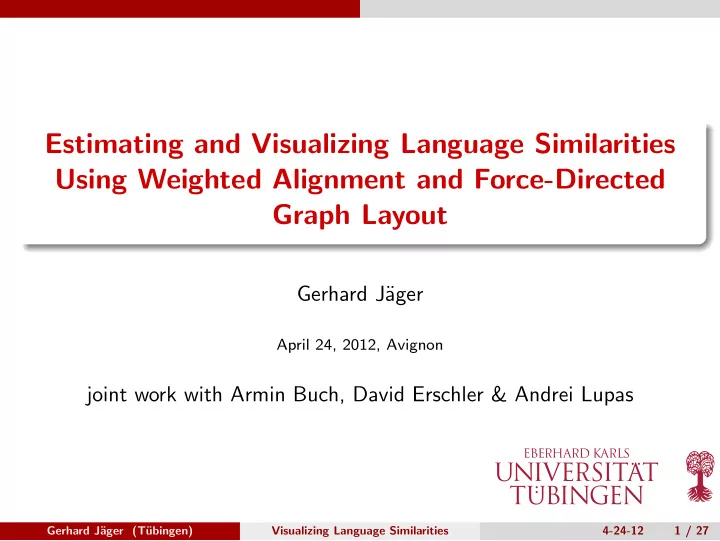

Estimating and Visualizing Language Similarities Using Weighted Alignment and Force-Directed Graph Layout Gerhard J¨ ager April 24, 2012, Avignon joint work with Armin Buch, David Erschler & Andrei Lupas Gerhard J¨ ager (T¨ ubingen) Visualizing Language Similarities 4-24-12 1 / 27
Force Directed Graph Layout method to visualize graphs or similarity matrices in two or three dimensions simulation of a physical system: data items ⇔ physical particles pairwise attractive force between particles proportional to their similarity constant repelling force between any pair of particles this is just one of many protocols to determine forces initially, all particles are placed at random in each time step, each particle is move a small amount along the resulting force vector last step is repeated until a stable state is reached tends to stabilize in a state where groups of mutually similar items form clusters Gerhard J¨ ager (T¨ ubingen) Visualizing Language Similarities 4-24-12 2 / 27
CLANS Cl uster An alysis of S equences developed by bioinformaticians Tancred Frickey and Andrei Lupas as exploratory tool to explore evolutionary relationships among protein sequences (Frickey and Lupas 2004) similarities of proteins is determined via sequence alignment; resulting matrix is visualized using CLANS advantages in comparison to tree-based algorithms: does not a priori assume a tree like signal (useful when lateral transfer plays a role) fast (esp. in comparison to character based algorithms) robust (noise in data items does not accumulate) general impression so far (Lupas, p.c.): tree algorithms are more precise when evolutionary distances are small; CLANS is more sensitive to weak evolutionary signals Gerhard J¨ ager (T¨ ubingen) Visualizing Language Similarities 4-24-12 3 / 27
The Automated Similarity Judgment Program Project at MPI EVA in Leipzig around S¨ oren Wichmann covers more than 5,000 languages basic vocabulary of 40 words for each language, in uniform phonetic transcription freely available used concepts: I, you, we, one, two, person, fish, dog, louse, tree, leaf, skin, blood, bone, horn, ear, eye, nose, tooth, tongue, knee, hand, breast, liver, drink, see, hear, die, come, sun, star, water, stone, fire, path, mountain, night, full, new, name Gerhard J¨ ager (T¨ ubingen) Visualizing Language Similarities 4-24-12 4 / 27
First shot: Levenshtein Distance first step: finde minmal edit distance between all translation pairs of the languages to be compared e.g. German ↔ Latin edit distance = 2 transformation into similarity measure = 2(max( l ( x ) , l ( y )) − d Lev ( x, y )) sim( x, y ) . l ( x ) + l ( y ) similarity between L1 and L2: average similarity of translation pairs between L1 and L2 Gerhard J¨ ager (T¨ ubingen) Visualizing Language Similarities 4-24-12 5 / 27
First shot: normalized Levenshtein Distance Gerhard J¨ ager (T¨ ubingen) Visualizing Language Similarities 4-24-12 6 / 27
First shot: normalized Levenshtein Distance Gerhard J¨ ager (T¨ ubingen) Visualizing Language Similarities 4-24-12 7 / 27
Recommend
More recommend